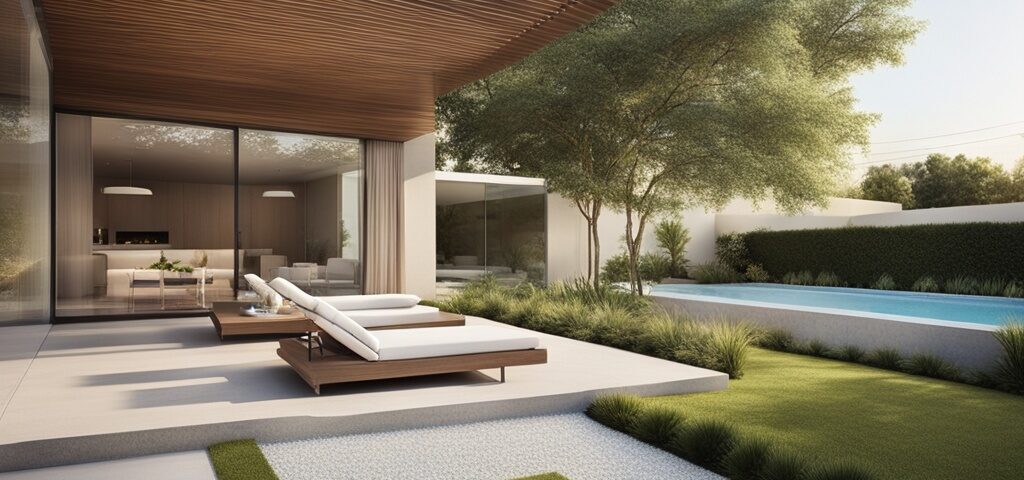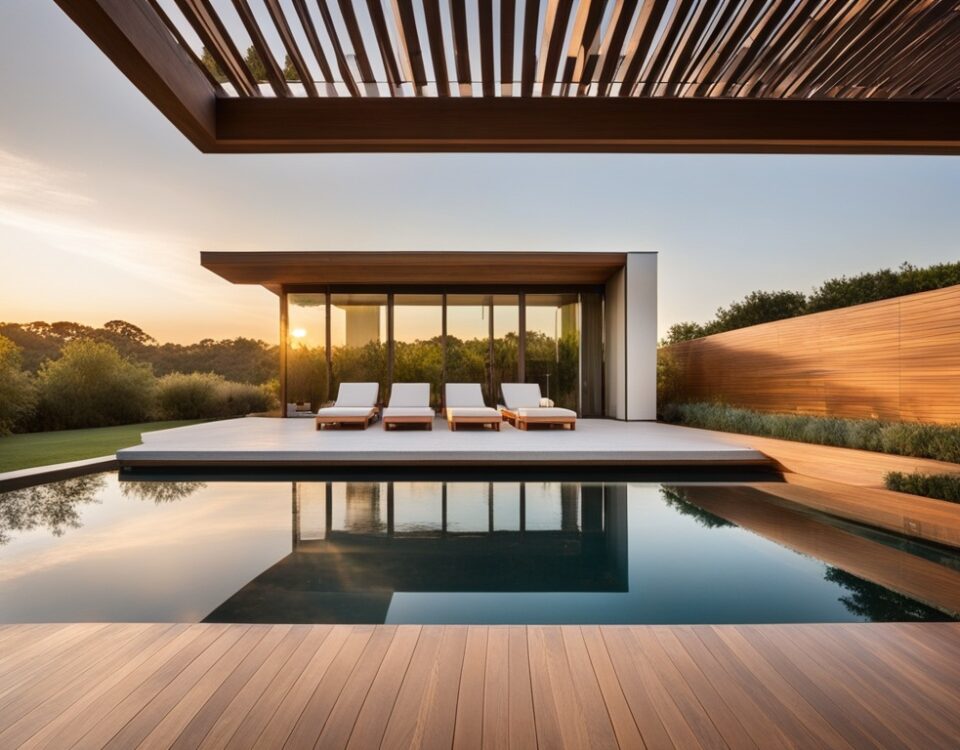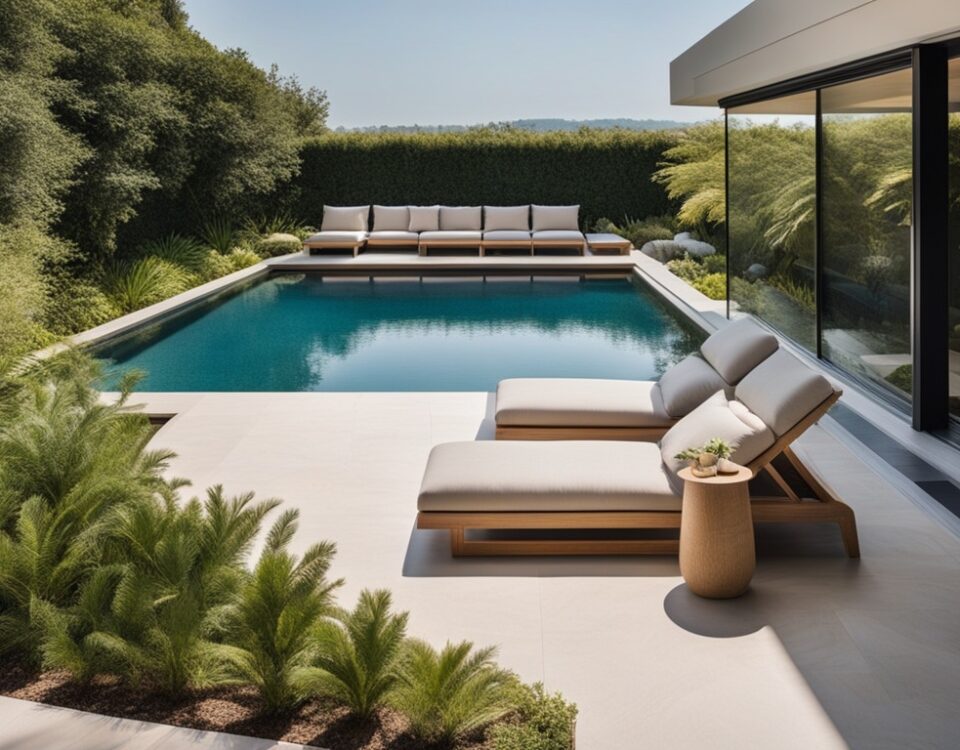Sleek Serenity: 10 Minimalist Pool Design Ideas to Transform Your Space

Ultimate Guide: Selecting the Top Pool Deck Materials for Your Oasis
May 9, 2025
Master Your Oasis: Essential Pool Maintenance Checklist
May 10, 2025The Beauty of Minimalist Pool Design
In recent years, the trend of minimalist pool designs has surged in popularity among homeowners and architects alike. This style emphasizes an uncluttered aesthetic that resonates with the growing desire for simplicity in modern living. With more individuals looking to create serene outdoor spaces that complement their lifestyles, the minimalist pool has emerged as a perfect embodiment of elegance and tranquility.
The Appeal of Simplicity
The allure of *simplicity* in pool design lies primarily in its ability to evoke a sense of calm and order. Clean lines and unobtrusive elements create a visual harmony that often eludes more ornate styles. A minimalist pool focuses on essential features, ensuring that each element serves a purpose while contributing to the overall ambiance. This reduces visual clutter, fostering a sanctuary-like atmosphere where one can unwind and rejuvenate.
Stunning Examples of Minimalist Pools
Across the globe, several stunning minimalist pools stand as testaments to the beauty of this design ethos. One notable example is the *Skyfall Infinity Pool* in Bali, Indonesia*, which offers breathtaking views of the surrounding landscape. The pool’s understated design integrates seamlessly with the natural environment, featuring glass edges that create an illusion of water blending into the horizon.
Another remarkable instance is the Nexus Pool at the *Amangiri Resort* in Utah, USA*. Characterized by its geometric shapes and natural stone decking, this infinity pool exudes sophistication. The design cleverly incorporates the desert landscape, enhancing the visual connection between the pool and its surroundings while maintaining a modern aesthetic.
Materials and Techniques
To achieve the essence of minimalist pool design, it’s crucial to select the right materials and techniques. For instance, using neutral colors and smooth finishes can enhance the clean lines that define this style. Options such as white plaster or natural stone tiles can create a sophisticated look that remains visually appealing without overwhelming the senses. Additionally, *integrating natural elements*, like strategically placed plants or rocks, can further enhance the pool’s connection to the environment while adhering to minimalist principles.
Functionality and Design
The integration of functionality and design is fundamental in minimalist pool projects. These pools often feature innovative technology, including automated covers and filtration systems, which simplify maintenance while ensuring the design remains uncluttered. By eliminating unnecessary features, minimalist pools not only enhance aesthetic value but also promote a more efficient use of resources, aligning perfectly with sustainable living trends.
| Location | Design Feature | Material Used |
|---|---|---|
| Bali, Indonesia | Infinity Edge | Glass and Natural Stone |
| Utah, USA | Geometric Shapes | Neutral Plaster and Stone |
| Auckland, New Zealand | Sunken Design | Concrete and Wood |
Incorporating Natural Elements
One of the most captivating aspects of minimalist pool design is its ability to seamlessly integrate with the surrounding environment. By prioritizing *natural elements* such as plants and stone, homeowners can create a tranquil oasis that resonates with the serene aesthetics of nature. Minimalist pools often emphasize clean lines and simplicity, making the incorporation of organic materials essential in establishing a harmonious balance between human-made structures and the natural landscape.
Integrating Greenery
*Lush vegetation* can significantly enhance the minimalist aesthetic of a pool area. Incorporating carefully selected plants—such as low-maintenance succulents, ornamental grasses, or strategically placed palm trees—can create a visually striking contrast against the sleek lines of a minimal pool. Moreover, using native plants not only aligns with minimalist principles but also supports local ecosystems and reduces water consumption.
Utilizing Natural Stone
The use of *natural stone* is another compelling design strategy for minimalist pools. Whether it be flagstone, slate, or river rock, incorporating stone can imbue the space with a timeless elegance. For example, a stone tile pool deck can lead the eye towards the water while providing a rugged texture that connects beautifully with earth tones. The *textured surfaces* of stone can soften the modern aspects of the pool, enhancing the overall organic feel of the space.
Landscaping for Minimalism
Thoughtful landscaping plays a crucial role in achieving a minimalist aesthetic around pools. Clean, well-defined planting beds with minimal clutter help to create a sense of *open space*. Consider employing a monochromatic color palette alongside strategic pruning to maintain a tidy appearance. Employing gravel or sand as a ground cover rather than traditional grass can also contribute to a more minimalist feel, allowing the pool and its natural surroundings to take center stage.
Blending the Pool with Surroundings
To achieve a seamless integration of the pool with its environment, focus on *design principles* that enhance visual continuity. For instance, consider constructing the pool in subtle, organic shapes that mimic the contours of the landscape. Additionally, using reflective surfaces can visually expand the space, blurring the lines between water and earth. The careful positioning of the pool in relation to trees and shrubs can also provide shade and create a naturally inviting atmosphere.
Practical Tips for Natural Integration
For those looking to bring nature into their minimalist pool design, here are some practical tips:
| Tip | Description |
|---|---|
| Choose Native Plants | Opt for local flora that thrives in your region’s climate, ensuring sustainability and minimal upkeep. |
| Incorporate Stone Features | Use rocks or stone walls around your pool to enhance the natural feel while providing stability and durability. |
| Maintain Open Space | Keep landscapes uncluttered to focus on the pool’s simplicity; avoid overly colorful flowers or busy patterns. |
| Consider Seasonal Changes | Plan for plants that offer beauty through all seasons, ensuring a dynamic view year-round. |
Maximizing Space in Small Yards
In the modern era, where urban living is the norm, the demand for minimally designed pools in limited spaces has surged. Innovative solutions allow homeowners to integrate chic and functional swimming pools into their small yards without compromising their aesthetics or utility. By embracing minimalist pool design principles, one can create a serene oasis that not only serves as a recreational retreat but also enhances the overall charm of a compact outdoor area.
Creative Solutions for Compact Pool Designs
One of the most effective approaches to designing a minimalist pool in a small yard is the adoption of *linear shapes and sleek lines*. Rectangular or oval pools are particularly well-suited for narrow spaces, allowing the water feature to blend harmoniously with the surrounding landscape. Coupled with a minimalist deck, these shapes can create an illusion of more space, drawing the eye outward and offering an inviting atmosphere. Furthermore, by utilizing transparent pool walls or incorporating natural elements like rocks and plants, the design can enhance the perception of depth and openness.
Benefits of Compact Pool Designs for Urban Environments
Beyond aesthetic considerations, *compact pool designs* provide myriad benefits, especially in urban environments. Firstly, they occupy a smaller footprint, thus reducing the overall maintenance required. This is particularly advantageous for city dwellers who may have limited time to devote to pool upkeep. Moreover, a smaller pool often necessitates less water, making it an environmentally friendly alternative, thus appealing to conscious consumers who value sustainability. Furthermore, a compact pool can enhance property value—a well-designed aquatic element is a sought-after feature in many real estate markets.
Space-Saving Features to Consider
Incorporating *space-saving features* into your minimalist pool design can further optimize your small yard. One such feature includes built-in benches, which provide relaxation spots without requiring additional furniture. This multifunctional approach not only maximizes space but also encourages social interaction among family and friends. Additionally, the use of *vanishing edges* and infinity pools can create a stunning visual effect and impart a sense of endlessness, making the pool appear larger than it truly is.
| Feature | Benefit |
|---|---|
| Built-in Benches | Maximizes seating without extra furniture |
| Rectangular Shapes | Enhances space perception; easy to integrate into landscaping |
| Vanishing Edges | Creates a stunning visual effect; promotes a sense of openness |
| Compact Depth | Reduces water volume for easier maintenance |
By harmonizing aesthetics with functionality, homeowners can achieve a pool design that transcends the limitations of space. Choosing the right materials further aids in enhancing *minimalist appeal*; for instance, light-colored tiles can reflect sunlight, contributing to an airy feel. The key to succeeding with a minimalist pool lies in thoughtful selections and intentional designs that prioritize both function and form, proving that even the smallest of yards can house magnificent watery sanctuaries.
Sustainable and Eco-Friendly Pool Design
Embracing a minimalist aesthetic in pool design does not only elevate the visual appeal of outdoor spaces but also holds the potential for significant environmental benefits. By focusing on simplicity, *minimalist pool designs can harmoniously integrate with nature*, promoting sustainability and reducing ecological footprints. Central to this philosophy is the notion that less is more, allowing for pools that serve both functional and aesthetic purposes without compromising on environmental integrity.
Energy-Efficient Materials and Technologies
One of the pillars of a sustainable pool design is the use of energy-efficient materials and technologies. Opting for natural stone, recycled materials, or locally sourced products can dramatically reduce the carbon footprint associated with transportation and manufacturing. Further, integrating energy-efficient features such as solar heating systems, variable-speed pumps, and LED lighting can dramatically lower energy consumption. These innovations not only create a pool that costs less to operate but also ensures a responsible approach to natural resource utilization.
| Technology | Description | Benefits |
|---|---|---|
| Solar Panels | Harvest sunlight to heat pool water | Reduces energy costs and emissions |
| Variable-Speed Pumps | Adjustable motor speeds for optimum performance | Lower energy use and noise |
| LED Lighting | Energy-efficient lighting for pool areas | Long lifespan and reduced electricity use |
Eco-Conscious Maintenance Practices
To ensure that a minimalist pool remains eco-friendly long after its construction, adopting sustainable maintenance practices is essential. Regularly checking and optimizing the pool’s chemical balance minimizes the need for harsh chemicals, which can damage surrounding ecosystems. Using automatic pool covers not only conserves heat but also prevents debris accumulation, reducing the need for excessive cleaning. Furthermore, *planting native vegetation around the pool* can help water retention in the soil, promoting a natural filtration process that keeps the water cleaner.
Implementing a *green waste management strategy*—such as composting organic debris or using a pool skimmer that collects waste—also contributes to a sustainable ecosystem. Homeowners can replace traditional chlorine with natural alternatives, such as saltwater systems or mineral sanitizers, which require less energy and reduce harmful chemical usage. Each of these practices creates a synergy between the pool and its surrounding environment, reinforcing the minimalist design’s ethos of simplicity and sustainability.
Streamlined Pool Features
In the quest for eco-friendly minimalist designs, curating streamlined pool features becomes imperative. Opting for *infinity edges or natural swimming ponds* can seamlessly merge the pool with its surroundings while conserving water. Additionally, incorporating biophilic elements, such as integrated planters or vegetation walls, can enhance the aesthetic while promoting biodiversity. By choosing streamlined and multifunctional elements, the minimalist pool design becomes not just a feature but a *contributing factor to ecological balance* and *sustainability*.
Minimalist Pool Accessories and Décor
Embracing a minimalist aesthetic in pool design extends beyond the water itself; it invites creativity in the selection of accessories and décor that seamlessly enhance the overall ambience. The essence of minimalism lies in the *simplicity* and *functionality* of each element. Choosing accessories that adhere to these principles can transform a standard pool area into a serene oasis.
Functional Furniture: The Heart of Minimalist Design
The poolside area serves as a relaxation zone, making the selection of furniture particularly crucial. Opt for *simple, geometric shapes* that do not overwhelm the senses. Materials such as teak or aluminum provide durability while embodying a clean aesthetic. Consider lounge chairs with a minimalist design; their sleek lines and muted color palettes align beautifully with the tranquil environment, ensuring they enhance rather than distract from the pool’s visual appeal.
Strategic Use of Color and Texture
In minimalist pool décor, less is invariably more. A limited color palette—predominantly neutral tones such as whites, grays, and earth tones—can create a serene environment. Accompany these shades with carefully selected textures, such as a soft cotton pool towel or a natural fiber outdoor rug. Such elements offer warmth while maintaining a *functional simplicity*, reinforcing the minimalist ethos and providing a subtle contrast that enhances visual interest.
Essential Accessories: Enhancing Comfort Without Clutter
Accessorizing your pool area need not result in a cluttered look. Instead, choose a select few pivotal items that serve both aesthetic and practical purposes. A sleek, modern fire pit can add warmth during the cooler months, while minimalist water features can introduce tranquil sounds without overpowering the design. Moreover, a well-placed umbrella or shade structure can offer respite from the sun, designed with a streamlined silhouette that complements the space.
The Role of Minimalism in Poolside Décor
The importance of minimalism in poolside décor cannot be overstated. By curating a selection of accessories that speak to *functional beauty*, homeowners can create an inviting atmosphere that transcends typical pool environments. Each piece should serve a purpose, whether it’s for relaxation, aesthetics, or convenience. By eliminating excessive ornamentation, the focus remains on the serene water and surrounding landscape, inviting a sense of calm and clarity.
| Accessory Type | Features | Benefits |
|---|---|---|
| Lounge Chairs | Sleek design, weather-resistant materials | Comfortable seating, easy maintenance |
| Umbrellas | Minimalist structure, neutral colors | Sun protection, stylish addition |
| Fire Pits | Geometric shapes, compact size | Warmth, social gathering space |
| Water Features | Simple designs, incorporated lighting | Soothing ambiance, visual focal point |
In conclusion, incorporating minimalist accessories and décor into pool design is about achieving a harmonious balance between beauty and functionality. By focusing on *essential elements* that reflect the ethos of minimalism, one can create a tranquil and inviting poolside retreat that enhances the overall lifestyle experience.
Creating a Zen Oasis with Minimalist Pool Design
Minimalist pool designs are not merely aesthetically pleasing; they are the epitome of tranquility, blending seamlessly with nature and fostering a serene atmosphere. By stripping down the unnecessary, minimalist pools create a *peaceful sanctuary* where one can unwind and rejuvenate. This design philosophy emphasizes the beauty of simplicity, encouraging a harmonious relationship between the environment and the elements of water. In essence, a minimalist pool functions as a canvas upon which relaxation and mindfulness can be painted.
Enhancing Tranquility with Water Features
Incorporating subtle water features into a minimalist pool design can significantly amplify its zen-like qualities. Consider the addition of *gentle waterfalls or tranquil fountains* that introduce the soothing sounds of flowing water. This auditory element not only enhances the sensory experience but also drowns out external distractions, allowing for deeper relaxation. The rhythmic sound of water can help calm the mind, promoting a meditative state ideal for mindfulness practices. To maintain the minimalist ethos, opt for sleek, simple designs that echo the overall aesthetic of the pool area.
Illuminating Peaceful Ambiance with Strategic Lighting
Lighting plays a crucial role in establishing a tranquil atmosphere around your minimalist pool. Soft, understated lighting options, such as *subtle LED strips or lanterns*, create an inviting ambiance without overpowering the serene visuals. Incorporate adjustable lights to tailor the environment according to your mood—whether a soft glow for evening relaxation or a bright beam for playful gatherings. It is essential to choose lighting fixtures that blend with the *natural surroundings*, ensuring that they contribute to the overall peace rather than serving as distractions.
Incorporating Elements of Relaxation
To cultivate a true zen oasis, consider integrating elements that promote relaxation and mindfulness. For example, comfortable yet simple loungers strategically placed around the pool can create inviting spaces for reflection and quietude. Incorporate natural materials such as *bamboo or stone* for furniture and landscaping to enhance the connection with nature. Planting soothing greenery—like lavender or bamboo—provides not only visual appeal but also contributes to the calming scents that envelop the space, encouraging deeper relaxation.
Creating Mindfulness Zones
Establishing designated mindfulness zones within the pool area can further enhance the sense of tranquility. Incorporate *comfortable seating areas* adorned with cushions in neutral tones that seamlessly blend with the overall decor. Consider adding a small meditation platform or an elevated terrace where one can engage in yoga or tai chi, connecting body and mind. These nurturing spaces allow individuals to step away from daily stressors, fostering an environment ripe for introspection and serenity.
Maintaining Minimalism in Design Choices
When designing a minimalist pool space, it is vital to adhere to principles that prioritize simplicity and functionality. Avoid clutter by selecting only essential items, such as *a few well-placed potted plants or minimalist sculptures*. Keep the color palette neutral, utilizing soft whites, grays, and earth tones to create a cohesive look. By focusing on quality over quantity, you ensure that each element serves a purpose, coalescing to create an *unbroken sense of peace* and allowing the mind to rest amidst the beauty of simplicity.
The Future of Minimalist Pool Design
As we gaze into the horizon of architectural innovation, it is evident that the future of minimalist pool design is both bright and transformative. Emerging trends suggest a refined focus on *simplicity*, *sustainability*, and *technology*, blending aesthetics with functionality in a way that speaks to contemporary sensibilities. The quest for tranquility and balance in residential spaces will continue to inspire homeowners, architects, and designers alike, steering them towards increasingly sophisticated minimalistic approaches.
Upcoming Trends in Minimalist Pool Design
One of the most significant trends emerging in minimalist pool design is the integration of *natural elements*. Pools are transforming into extensions of their environments, with designs that incorporate lush greenery, stones, and water features that harmonize with the surroundings. Expect to see pools that reflect their locales, featuring organic shapes and subdued color palettes that blend seamlessly with nature. Additionally, the incorporation of geometric forms will continue to inspire, with rectangular, angular, and circular pool designs emerging as favored choices that encapsulate the essence of minimalism.
Technology and Innovation Shaping Pool Design
Innovation is reshaping the landscape of pool design in remarkable ways. Advancements in *smart technology* allow for unparalleled control over pool environments, enabling homeowners to manage water temperature, filtration systems, and lighting through mobile devices. The integration of energy-efficient heating systems and solar-powered mechanisms contributes to sustainability while remaining in harmony with minimalist ideals. Furthermore, the introduction of automated cleaning solutions and advanced water purification systems ensures that the focus remains on aesthetic enjoyment rather than maintenance.
The Continued Evolution of Minimalist Aesthetics
The minimalist aesthetic is on a continual trajectory towards *refined simplicity*. Future designs will likely incorporate smoother textures and less ornamentation, emphasizing open spaces and clean lines. Pools may feature infinity edges that create a seamless transition into surrounding landscapes, providing a visual illusion of expansive tranquility. The interplay of light and water will become increasingly important, with designs that focus on how natural light interacts with the pool’s structure, enhancing the serene atmosphere that minimalist design seeks to achieve.
Data Table: Minimalist Pool Design Trends
| Trend | Description | Impact on Design |
|---|---|---|
| Natural Integration | Using natural materials and surroundings | Enhances the aesthetic and harmony with nature |
| Smart Technology | Automation and smart system integration | Improves usability and efficiency |
| Geometric Forms | Clean, defined shapes | Strengthens minimalist design principles |
| Infinity Edges | Seamless transition to surroundings | Creates visual depth and tranquility |
In conclusion, the future of minimalist pool design is poised to cultivate a deeper relationship between humans and their environments. As we embrace new materials, technologies, and conceptual frameworks, the minimalist pool will not only be a symbol of prestige but also a sanctuary of peace, reflecting a lifestyle committed to mindfulness and simplicity.
Learn more about Swimming Pool

Javier Morales is passionate about pool design, maintenance, and outdoor living. With years of hands-on experience, he offers practical tips, creative ideas, and expert insights to help readers make the most of their pool spaces. At Piscina Planet, Javier shares everything from seasonal care guides to the latest trends in pool innovation.




